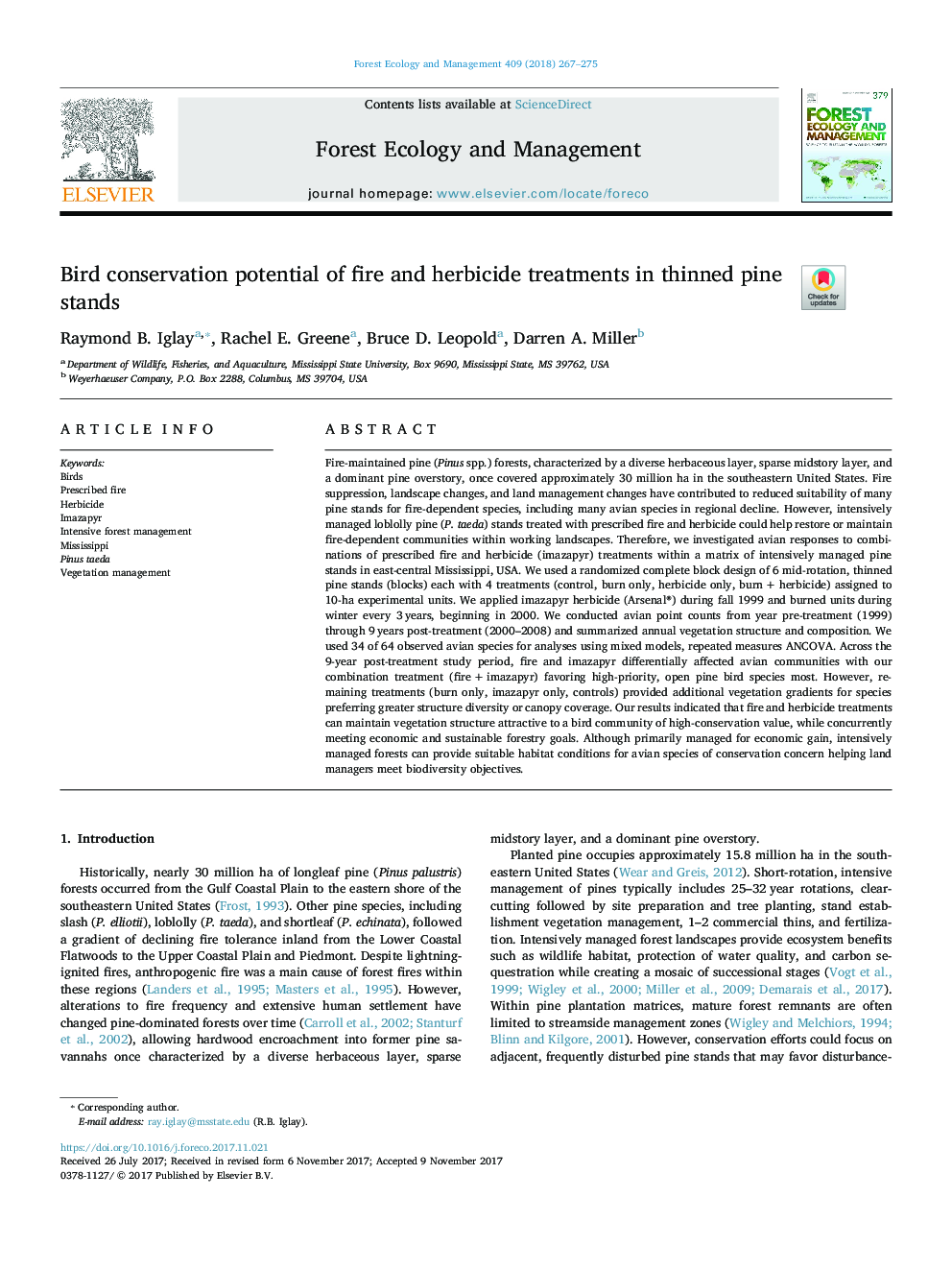| کد مقاله | کد نشریه | سال انتشار | مقاله انگلیسی | نسخه تمام متن |
|---|---|---|---|---|
| 6541896 | 1421349 | 2018 | 9 صفحه PDF | دانلود رایگان |
عنوان انگلیسی مقاله ISI
Bird conservation potential of fire and herbicide treatments in thinned pine stands
ترجمه فارسی عنوان
پتانسیل حفاظت از پرندگان در برابر تداخل آتش و علف کش در کاج های کاج خرد شده
دانلود مقاله + سفارش ترجمه
دانلود مقاله ISI انگلیسی
رایگان برای ایرانیان
کلمات کلیدی
موضوعات مرتبط
علوم زیستی و بیوفناوری
علوم کشاورزی و بیولوژیک
بوم شناسی، تکامل، رفتار و سامانه شناسی
چکیده انگلیسی
Fire-maintained pine (Pinus spp.) forests, characterized by a diverse herbaceous layer, sparse midstory layer, and a dominant pine overstory, once covered approximately 30 million ha in the southeastern United States. Fire suppression, landscape changes, and land management changes have contributed to reduced suitability of many pine stands for fire-dependent species, including many avian species in regional decline. However, intensively managed loblolly pine (P. taeda) stands treated with prescribed fire and herbicide could help restore or maintain fire-dependent communities within working landscapes. Therefore, we investigated avian responses to combinations of prescribed fire and herbicide (imazapyr) treatments within a matrix of intensively managed pine stands in east-central Mississippi, USA. We used a randomized complete block design of 6 mid-rotation, thinned pine stands (blocks) each with 4 treatments (control, burn only, herbicide only, burnâ¯+â¯herbicide) assigned to 10-ha experimental units. We applied imazapyr herbicide (Arsenal®) during fall 1999 and burned units during winter every 3â¯years, beginning in 2000. We conducted avian point counts from year pre-treatment (1999) through 9â¯years post-treatment (2000-2008) and summarized annual vegetation structure and composition. We used 34 of 64 observed avian species for analyses using mixed models, repeated measures ANCOVA. Across the 9-year post-treatment study period, fire and imazapyr differentially affected avian communities with our combination treatment (fireâ¯+â¯imazapyr) favoring high-priority, open pine bird species most. However, remaining treatments (burn only, imazapyr only, controls) provided additional vegetation gradients for species preferring greater structure diversity or canopy coverage. Our results indicated that fire and herbicide treatments can maintain vegetation structure attractive to a bird community of high-conservation value, while concurrently meeting economic and sustainable forestry goals. Although primarily managed for economic gain, intensively managed forests can provide suitable habitat conditions for avian species of conservation concern helping land managers meet biodiversity objectives.
ناشر
Database: Elsevier - ScienceDirect (ساینس دایرکت)
Journal: Forest Ecology and Management - Volume 409, 1 February 2018, Pages 267-275
Journal: Forest Ecology and Management - Volume 409, 1 February 2018, Pages 267-275
نویسندگان
Raymond B. Iglay, Rachel E. Greene, Bruce D. Leopold, Darren A. Miller,
